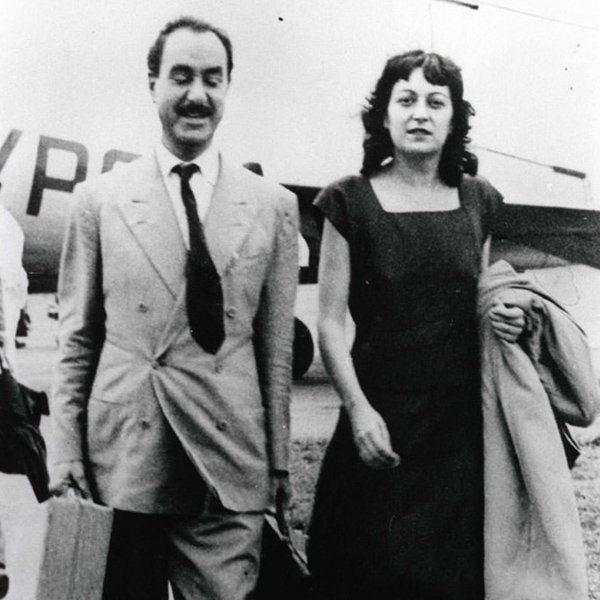LINA BO BARDI
WOMEN IN DESIGN / LINA BO BARDI
The world of design is largely shaped by countless women before us whose work and philosophies continue to have a resounding impact on the world; inciting inspiration in generations to come.
In honor of Women’s History Month, we are paying homage to the trailblazing visionaries who have inspired us at Form + Field. Each month and over the course of the year, we will highlight a designer for an opportunity to immerse yourself in their world.
The true embodiment of the word “multifaceted,” Lina Bo Bardi’s achievements spanned fields as: architect, designer, illustrator, furniture designer, editor, curator, educator, and activist.
Her career began in Italy amidst political upheaval and tensions of World War II. Shortly after the war, Lina Bo met Pietro Maria Bardi, an established and well-respected art dealer and journalist. The couple married and (for unconfirmed reasons) emigrated from Italy to Brazil with their belongings and collected works in tow. Many have speculated the decision to uproot their lives was due to her husband’s political involvements that sparked concerns for the couple.
Lina Bo Bardi’s Garden of the Glass House (Casa de Vidro) in São Paulo Brazil
A PURPOSE-DRIVEN DUO
Despite working in a male-dominated industry, Bo Bardi harnessed her passion and was at the helm of shifting the world of design. In 1950, she and her husband joined forces, founding Habitat, the most influential architectural magazine in Brazil during the time.
Pietro and Lina Bo Bardi (source)
(source)
She served as the magazine’s editor for three years. Shortly after becoming a citizen of Brazil, she created momentum and established the country’s first industrial design course at the Institute of Contemporary Art, an arm of the São Paulo Museum of Art (MASP).
LIFE IN BRAZIL
Photo: Instituto Lina Bo e P.M. Bardi, The Tale of Tomorrow
Bo Bardi embarked on what she referred to as an “anthropological quest,” spending nearly five years immersing herself in Brazilian culture and developing relationships with the Brazilian communities. This time greatly influenced her works to come, putting people at the center of her projects while championing for the underserved and least culturally represented.
THE ART MUSEUM OF SÃO PAULO
MASP designed by Bo Bardi (source) via Instituto Bardi
The husband and wife duo married their visions and collaborated on São Paulo Museum of Art (MASP), working closely with one another. With an unconventional perspective on museum curation, Bo Bardi inspired what was considered to be new and unique methods of displaying works.
Bo Bardi’s exhibition “The Hand of the Brazilian People” (1969-2017) at MASP (source)
Instead of defaulting to the traditional ways of curating artwork where the negative space of walls were maximized, Bo Bardi created two innovative exhibitions within the suspended building. On the first level, an installation she named “The Hand of the Brazilian People” consisted of hundreds of handcrafted objects sourced from local artists and makers across Brazil.
View of the gallery at MASP, São Paulo, 1970. Courtesy: the artist and Collection Instituto Bard, Casa de Vidro, São Paulo; photograph: Paolo Gasparini (source)
On the second level, hundreds of prized Western works were displayed across the spacious floor. Each canvas that appeared to be suspended in mid-air, was in fact supported by a standing glass pane and anchored by a concrete cube; creating a dynamic viewing experience.
Though visually pleasing, the foundation of her works sought to deepen one's connection to the humanity around them.
HER LEGACY: PEOPLE FIRST
Lina Bo Bardi at a work meeting at MASP. Image courtesy of Instituto Bardi. (source)
Bo Bardi faced many adversities over the course of her career, the primary challenge was being a woman working in an industry over-saturated by her male counterparts. Her ingenuity and modernist perspective was also met with resistance from the traditionalists operating at the time.
The obstacles faced empowered Bo Bardi to harness her voice, assert her vision, and receive recognition as one of the most prolific women architects of the 20th century.
Her altruistic tendencies deeply resonate with our core Design Philosophies:
Individualism: Centering our work around the needs and desires of our clients, at all costs, people come first.
Integration: Work holistically with all senses, the architecture, and surroundings, both physical and cultural — just as Bo Bardi navigated; continually drawing inspiration from the rich cultures and communities surrounding her works.
Balance: Create balance through juxtaposition — similar to her juxtaposition of art and artifacts.
Longevity: Craft environments and select materials that stand the test of time, with a deeper meaning that spark curiosity and leave a resounding impression.
The value of honoring people is present in her collection of works, studies, and teachings — serving as a reminder for those who are privileged to experience and marvel at her creations.
MORE WORK FROM LINA BO BARDI
Studio d'Arte Palma - Bo Bardi Furniture
SESC Pompéia Factory
Lina Bo Bardi Bowl Chair - 1951 (source)
Lina Bo Bardi Tripod Chairs designed in 1948 at Casati Gallery (source)
Sources:
https://www.britannica.com/biography/Lina-Bo-Bardi
http://www.harvarddesignmagazine.org/issues/16/after-the-flood
https://www.casatigallery.com/designers/lina-bo-bardi/
http://www.dreamideamachine.com/?p=54428
https://www.floornature.com/design-museum-gent-presents-lina-bo-bardi-giancarlo-palanti-15080/













